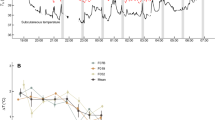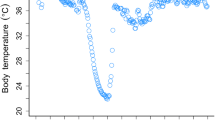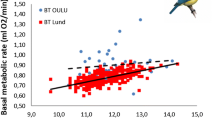Abstract
The growth/survival trade-off is a fundamental aspect of life-history evolution that is often explained by the direct energetic requirement for growth that cannot be allocated into maintenance. However, there is currently no empirical consensus on whether fast-growing individuals have higher resting metabolic rates at thermoneutrality (RMRt) than slow growers. Moreover, the link between growth rate and daily energy expenditure (DEE) has never been tested in a wild endotherm. We assessed the energetic and survival costs of growth in juvenile eastern chipmunks (Tamias striatus) during a year of low food abundance by quantifying post-emergent growth rate (n = 88), RMRt (n = 66), DEE (n = 20), and overwinter survival. Both RMRt and DEE were significantly and positively related to growth rate. The effect size was stronger for DEE than RMRt, suggesting that the energy cost of growth in wild animals is more likely to be related to the maintenance of a higher foraging rate (included in DEE) than to tissue accretion (included in RMRt). Fast growers were significantly less likely to survive the following winter compared to slow growers. Juveniles with high or low RMRt were less likely to survive winter than juveniles with intermediate RMRt. In contrast, DEE was unrelated to survival. In addition, botfly parasitism simultaneously decreased growth rate and survival, suggesting that the energetic budget of juveniles was restricted by the simultaneous costs of growth and parasitism. Although the biology of the species (seed-storing hibernator) and the context of our study (constraining environmental conditions) were ideally combined to reveal a direct relationship between current use of energy and future availability, it remains unclear whether the energetic cost of growth was directly responsible for reduced survival.



Similar content being viewed by others
References
Álvarez D, Nicieza AG (2005) Is metabolic rate a reliable predictor of growth and survival of brown trout (Salmo trutta) in the wild? Can J Fish Aquat Sci 62:643–649
Artacho P, Nespolo RF (2009) Natural selection reduces energy metabolism in the garden snail, Helix aspersa (Cornu aspersum). Evolution 63:1044–1050
Bacigalupe LD, Nespolo RF, Bustamante DM, Bozinovic F (2004) The quantitative genetics of sustained energy budget in a wild mouse. Evolution 58:421–429
Bayne BL (1999) Physiological components of growth differences between individual oysters (Crassostrea gigas) and a comparison with Saccostrea commercialis. Physiol Biochem Zool 72:705–713
Bayne BL (2000) Relations between variable rates of growth, metabolic costs and growth efficiencies in individual Sydney rock oysters (Saccostrea commercialis). J Exp Mar Biol Ecol 251:185–203
Bergeron P, Careau V, Humphries MM, Réale D, Speakman JR, Garant D (2011a) The energetic and oxidative costs of reproduction in a free-ranging rodent. Funct Ecol 25:1063–1071
Bergeron P, Réale D, Humphries MM, Garant D (2011b) Anticipation and tracking of pulsed resources drive population dynamics in eastern chipmunks. Ecology 92:2027–2034
Berteaux D, Thomas D (1999) Seasonal and interindividual variation in field water metabolism of female meadow voles Microtus pennsylvanicus. Physiol Biochem Zool 72:545–554
Biro PA, Stamps JA (2010) Do consistent individual differences in metabolic rate promote consistent individual differences in behavior? Trends Ecol Evol 24:653–659
Blackmer AL, Mauck RA, Ackerman JT, Huntington CE, Nevitt GA, Williams JB (2005) Exploring individual quality: basal metabolic rate and reproductive performance in storm-petrels. Behav Ecol 16:906–913
Bochdansky AB, Gronkjaer P, Herra TP, Leggett WC (2005) Experimental evidence for selection against fish larvae with high metabolic rates in a food limited environment. Mar Biol 147:1413–1417
Boratyński Z, Koteja P (2009) The association between body mass, metabolic rates and survival of bank voles. Funct Ecol 23:330–339
Boratyński Z, Koteja P (2010) Sexual and natural selection on body mass and metabolic rates in free-living bank voles. Funct Ecol 24:1252–1261
Boratyński Z, Koskela E, Mappes T, Oksanen TA (2010) Sex-specific selection on energy metabolism—selection coefficients for winter survival. J Evol Biol 23:1969–1978
Briffa M, Sneddon LU (2007) Physiological constraints on contest behaviour. Funct Ecol 21:627–637
Burton T, Killen SS, Armstrong JD, Metcalfe NB (2011) What causes intraspecific variation in resting metabolic rate and what are its ecological consequences? Proc R Soc Lond B. doi:10.1098/rspb.2011.1778
Butler PJ, Green JA, Boyd IL, Speakman JR (2004) Measuring metabolic rate in the field: the pros and cons of the doubly labelled water and heart rate methods. Funct Ecol 18:168–183
Careau V, Giroux JF, Berteaux D (2007) Cache and carry: hoarding behaviour of arctic fox. Behav Ecol Sociobiol 62:87–96
Careau V, Thomas DW, Humphries MM (2010) Energetic cost of bot fly parasitism in free-ranging eastern chipmunks. Oecologia 162:303–312
Careau V, Garant D, Humphries MM (2012a) Free-ranging eastern chipmunks (Tamias striatus) infected with bot fly (Cuterebra emasculator) larvae have higher resting but lower maximum metabolism. Can J Zool 90:413–421
Careau V, Réale D, Garant D, Speakman JR, Humphries MM (2012b) Stress-induced rise in body temperature is repeatable in free-ranging eastern chipmunks (Tamias striatus). J Comp Physiol B 182:403–414
Chappell MA, Bachman GC (1995) Aerobic performance in Belding’s ground squirrels (Spermophilus beldingi): variance, ontogeny, and the aerobic capacity model of endothermy. Physiol Zool 68:421–442
Chappell MA, Garland T Jr, Robertson GF, Saltzman W (2007) Relationships among running performance, aerobic physiology and organ mass in male Mongolian gerbils. J Exp Biol 210:4179–4197
Criscuolo F, Monaghan P, Nasir L, Metcalfe NB (2008) Early nutrition and phenotypic development: “catch-up” growth leads to elevated metabolic rate in adulthood. Proc Roy Soc B 275:1565–1570
Derting TL (1989) Metabolism and food availability as regulators of production in juvenile cotton rats. Ecology 70:587–595
Derting TL, McClure PA (1989) Intraspecific variation in metabolic rate and its relationship with productivity in the cotton rat, Sigmodon hispidus. J Mamm 70:520–531
Dmitriew CM (2011) The evolution of growth trajectories: what limits growth rate? Biol Rev 86:97–116
Humphries MM, Thomas DW, Hall CL, Speakman JR, Kramer DL (2002) The energetics of autumn mast hoarding in eastern chipmunks. Oecologia 133:30–37
Jackson DM, Trayhurn P, Speakman JR (2001) Associations between energetics and over-winter survival in the short-tailed field vole Microtus agrestis. J Anim Ecol 70:633–640
Jorgensen CB (1988) Metabolic costs of growth and maintenance in the toad, Bufo bufo. J Exp Biol 138:319–331
Koehn RK (1991) The cost of enzyme synthesis in the genetics of energy balance and physiological performance. Biol J Linn Soc 44:231–247
Konarzewski M (1995) Allocation of energy to growth and respiration in avian postembryonic development. Ecology 76:8–19
Konarzewski M, Diamond J (1995) Evolution of basal metabolic rate and organ masses in laboratory mice. Evolution 49:1239–1248
Konarzewski M, Gavin A, McDevitt R, Wallis IR (2000) Metabolic and organ mass responses to selection for high growth rates in the domestic chicken (Gallus domesticus). Physiol Biochem Zool 73:237–248
Koteja P (1996a) Limits to the energy budget in a rodent, Peromyscus maniculatus: does gut capacity set the limit? Physiol Zool 69:994–1020
Koteja P (1996b) Measuring energy metabolism with open-flow respirometric systems: which design to choose? Funct Ecol 10:675–677
Król E, Johnson MS, Speakman JR (2003) Limits to sustained energy intake VIII. Resting metabolic rate and organ morphology of laboratory mice lactating at thermoneutrality. J Exp Biol 206:4283–4291
Kuhn KM, Vander Wall SB (2008) Linking summer foraging to winter survival in yellow pine chipmunks (Tamias amoenus). Oecologia 157:349–360
Lande R, Arnold SJ (1983) The measurement of selection on correlated characters. Evolution 37:12101226
Landry-Cuerrier M, Munro D, Thomas DW, Humphries MH (2008) Climate and resource determinants of fundamental and realized metabolic niches of hibernating chipmunks. Ecology 89:3306–3316
Larivée ML, Boutin S, Speakman JR, McAdam AG, Humphries MM (2010) Associations between over-winter survival and resting metabolic rate in juvenile North American red squirrels. Funct Ecol 24:597–607
Levesque DL, Tattersall GJ (2010) Seasonal torpor and normothermic energy metabolism in the eastern chipmunk (Tamias striatus). J Comp Physiol B 180:279–292
Lima SL (1998) Stress and decision-making under the risk of predation: recent developments from behavioral, reproductive and ecological perspectives. Adv Study Behav 27:215–229
Lima SL, Dill LM (1990) Behavioral decisions made under the risk of predation: a review and prospectus. Can J Zool 68:619–640
Lindström J (1999) Early development and fitness in birds and mammals. Trend Ecol Evol 14:343–348
Mangel M, Stamps J (2001) Trade-offs between growth and mortality and the maintenance of individual variation in growth. Evol Ecol Res 3:583–593
McCarthy ID (2000) Temporal repeatability of relative standard metabolic rate in juvenile Atlantic salmon and its relation to life history variation. J Fish Biol 57:224–238
McNab BK (1980) Food-habits, energetics, and the population biology of mammals. Am Nat 116:106–124
McNab BK (1997) On the utility of uniformity in the definition of basal rate of metabolism. Physiol Zool 70:718–720
McPeek MA (2004) The growth/predation risk trade-off: so what is the mechanism? Am Nat 163:E88–E111
Nakagawa S, Cuthill IC (2007) Effect size, confidence interval and statistical significance: a practical guide for biologists. Biol Rev 82:591–605
Nespolo RF, Bacigalupe LD, Sabat P, Bozinovic F (2002) Interplay among energy metabolism, organ mass and digestive enzyme activity in the mouse-opossum Thylamys elegans: the role of thermal acclimation. J Exp Biol 205:2697–2703
Nespolo RF, Bustamante DM, Bacigalupe LD, Bozinovic F (2005) Quantitative genetics of bioenergetics and growth-related traits in the wild mammal, Phyllotis darwini. Evolution 59:1829–1837
Nilsson JA (2002) Metabolic consequences of hard work. Proc R Soc Lond B 269:1735–1739
Olson JM (1992) Growth, the development of endothermy, and the allocation of energy in red-winged blackbirds (Agelaius phoeniceus) during the nestling period. Physiol Zool 65:124–152
Peterson CC, Walton BM, Bennett AF (1998) Intrapopulation variation in ecological energetics of the garter snake Thamnophis sirtalis, with analysis of the precision of doubly labeled water measurements. Physiol Biochem Zool 71:333–349
Piersma T, van Gils JA (2011) The flexible phenotype: a body-centered integration of ecology, physiology, and behaviour. Oxford University Press, Oxford
Pinheiro JC, Bates DM (2000) Mixed-effects models in S and S-PLUS. Springer, New York
Roff DA (1992) The evolution of life histories: theory and analysis. Chapman and Hall, New York
Russell GA, Chappell MA (2007) Is BMR repeatable in deer mice? Organ mass correlates and the effects of cold acclimation and natal altitude. J Comp Physiol B 177:75–87
Sadowska ET, Baliga-Klimczyk K, Labocha MK, Koteja P (2009) Genetic correlations in a wild rodent: grass-eaters and fast-growers evolve high basal metabolic rate. Evolution 63:1530–1539
Selman C, Lumsden S, Bunger L, Hill WG, Speakman JR (2001) Resting metabolic rate and morphology in mice (Mus musculus) selected for high and low food intake. J Exp Biol 204:777–784
Speakman JR (1997) Doubly labelled water: theory and practice. Chapman and Hall, London
Speakman JR (2000) The cost of living: field metabolic rates of small mammals. Adv Ecol Res 30:177–297
Speakman JR, Król E (2005) Validation of the doubly-labelled water method in a small mammal. Physiol Biochem Zool 78:650–667
Speakman JR, Racey PA (1987) The equilibrium concentration of oxygen-18 in body water: Implications for the accuracy of the doubly-labelled water technique and a potential new method of measuring RQ in free-living animals. J Theor Biol 127:79–95
Speakman JR, Racey PA, Haim A, Webb PI, Ellison GTH, Skinner JD (1994) Inter-individual and intra-individual variation in daily energy expenditure of the pouched mouse (Saccostomus campestris). Funct Ecol 8:336–342
Speakman JR, Król E, Johnson MS (2004) The functional significance of individual variation in basal metabolic rate. Physiol Biochem Zool 77:900–915
Stearns SC (1992) The evolution of life histories. Oxford University Press, Oxford
Steyermark AC (2002) A high standard metabolic rate constrains juvenile growth. Zoology 105:147–151
Stoks R, De Block M, McPeek MA (2006) Physiological costs of compensatory growth in a damselfly. Ecology 87:1566–1574
Vander Wall SB (1990) Food hoarding in animals. University of Chicago Press, Chicago
Vézina F, Love OP, Lessard M, Williams TD (2009) Shifts in metabolic demands in growing altricial nestlings illustrate context-specific relationships between basal metabolic rate and body composition. Physiol Biochem Zool 82:248–257
Wang LCH, Hudson JW (1971) Temperature regulation in normothermic and hibernating eastern chipmunk. Comp Biochem Physiol 31:59–90
Wieser W (1994) Cost of growth in cells and organisms: general rules and comparative aspects. Biol Rev 69:1–33
Withers PC (1977) Measurements of VO2, VCO2 and evaporative water loss with a flow-through mask. J Appl Physiol 42:120–123
Yamamoto T, Ueda H, Higashi S (1998) Correlation among dominance status, metabolic rate and otolith size in masu salmon. J Fish Biol 52:281–290
Acknowledgments
We thank all field assistants who have helped to collect the data presented in this paper, D. Munro for coordination work, R. Morin for respirometry work, M. Landry-Cuerrier for help in the field with the DLW method, and P. Thompson and P. Redman for isotope analysis. We thank M. Chappell, J. Arendt, R. Nespolo, and an anonymous reviewer for insightful comments on previous drafts. This research was supported by a Québec FQRNT team grant, NSERC discovery grants to DR, DG, and MMH, and NSERC doctoral scholarships to VC and PB. The costs of the DLW analyses were covered by a NSERC discovery grant to Donald W. Thomas.
Author information
Authors and Affiliations
Corresponding author
Additional information
Communicated by Pawel Koteja.
Electronic supplementary material
Below is the link to the electronic supplementary material.
Rights and permissions
About this article
Cite this article
Careau, V., Bergeron, P., Garant, D. et al. The energetic and survival costs of growth in free-ranging chipmunks. Oecologia 171, 11–23 (2013). https://doi.org/10.1007/s00442-012-2385-x
Received:
Accepted:
Published:
Issue Date:
DOI: https://doi.org/10.1007/s00442-012-2385-x




